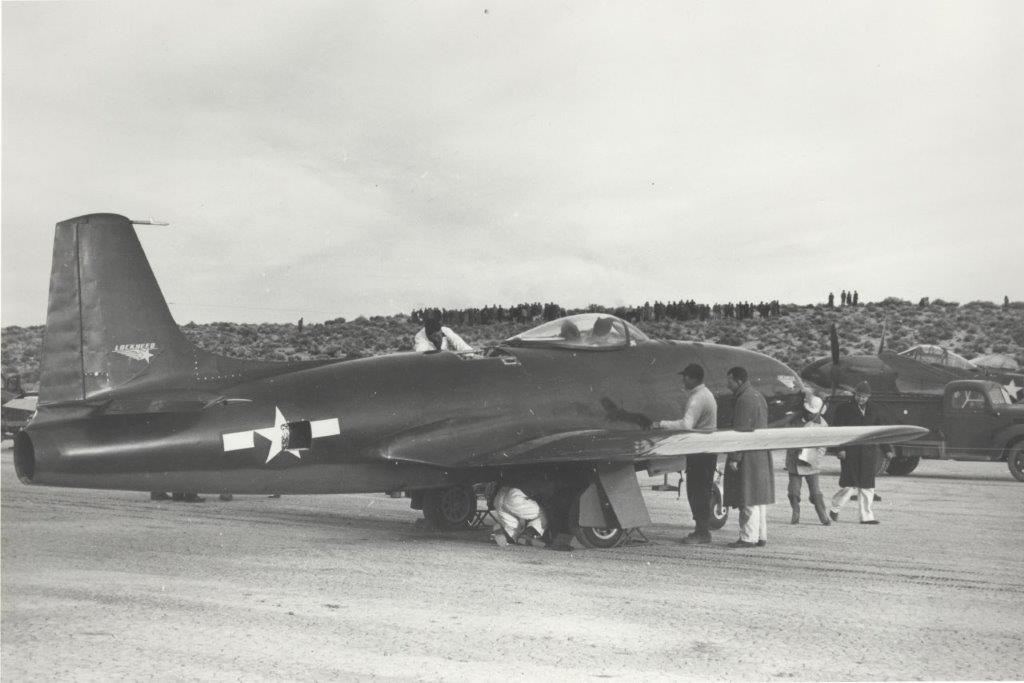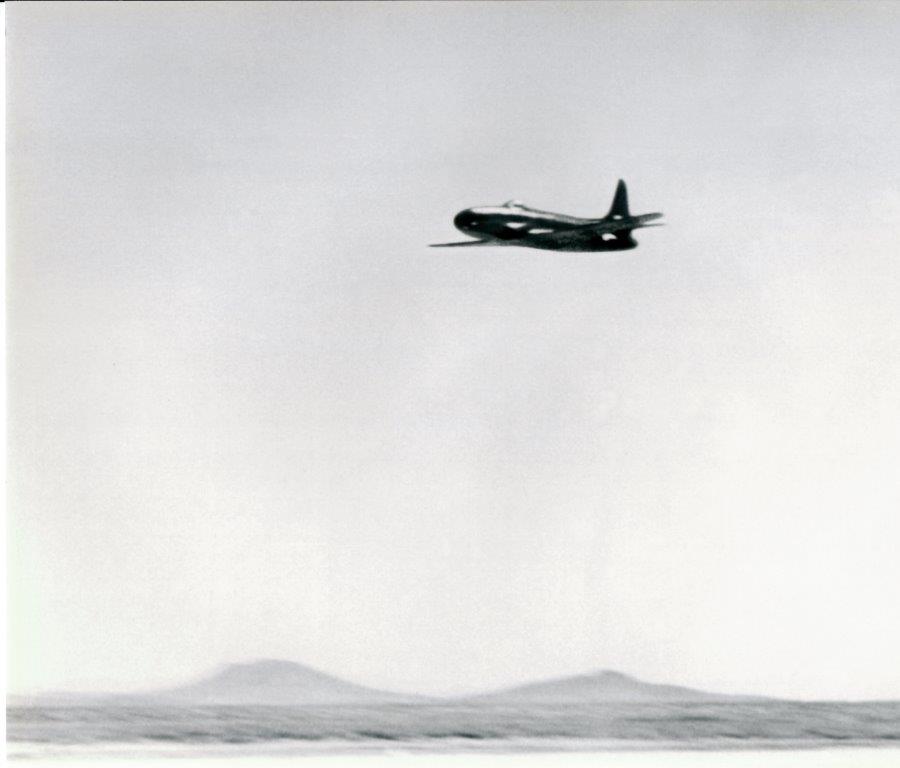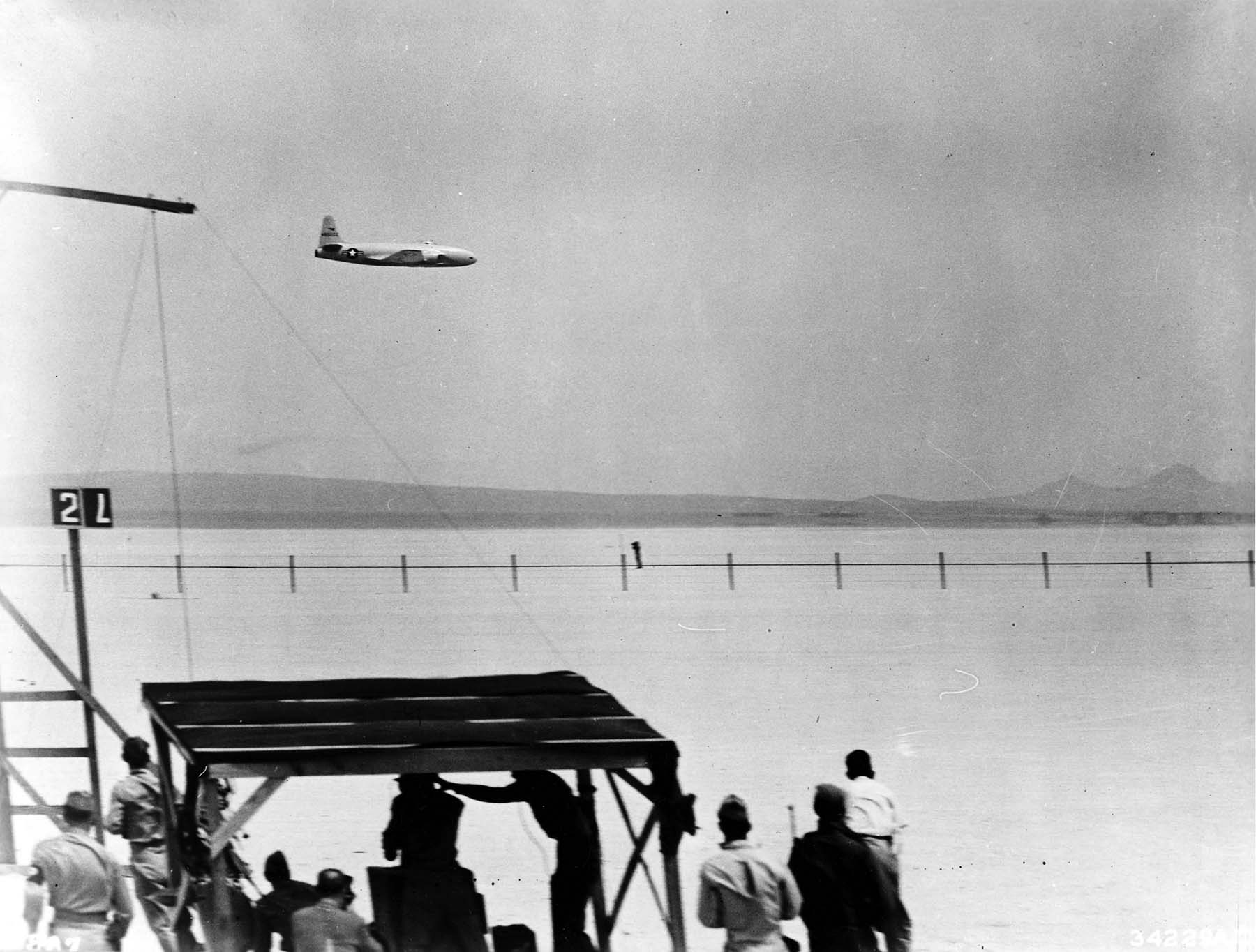The XP-80 was a result of the combined interest of both the Army Air Forces and Lockheed in producing a jet-propelled airplane of superior performance. While Lockheed representatives were here at Wright Field in May 1943, Army Air Force officials invited Lockheed to submit a design for a jet-propelled airplane using the British DeHavilland-built Halford H-1 engine used in the Vampire prototype. A month later, Lockheed presented a proposal to construct an airplane in approximately 180 days. Lockheed’s excellent performance figures and short period required to produce the airplane were factors warranting an immediate “go-ahead” on the project with a letter contract given six days later. 
Engineering started in May with inspections held at Lockheed’s Burbank plant in July. Complete, except for the power plant installation, the airplane was of such a simplified nature that only a few immediate changes were suggested. Various engine difficulties delayed the arrival of the Halford H-1 from England until Nov. 2. After installation of the engine, the XP-80 arrived at Muroc Flight Test Base for flight-testing but an engine accident occurred on Nov. 17 preventing the airplane from flying as scheduled. A second power plant arrived from England on Dec. 29 and the initial flight took place 75 years ago on Jan. 8, 1944. In official performance tests, the airplane achieved a speed of 502 miles an hour, becoming the first Army Air Forces airplane to exceed 500 miles an hour in level flight. Later in the month, Lockheed submitted a quote for two XP-80As using the General Electric I-40 engine. Completed in 132 days, the first  prototype arrived at Muroc in June and utilized primarily for purposes of improving and checking flight characteristics, stability, and control tests. The second prototype arrived in August and was a two-place arrangement to provide for an engineer observer behind the pilot. Following testing, the Engineering Division believed the XP-80A was tactically superior to the best Army Air Force fighter in use at the time.
prototype arrived at Muroc in June and utilized primarily for purposes of improving and checking flight characteristics, stability, and control tests. The second prototype arrived in August and was a two-place arrangement to provide for an engineer observer behind the pilot. Following testing, the Engineering Division believed the XP-80A was tactically superior to the best Army Air Force fighter in use at the time.
In March 1944, the Army Air Forces initiated a contract for an unusually large number of YP-80s in order to speed up service testing of the aircraft, requesting 13 airframes to be delivered by March 1945; however, Lockheed expedited the delivery schedule with the last airplane delivered in December 1944. The first accepted aircraft flew immediately to Moffett Field for instrumentation installation in connection with high-speed research for the National Advisory Committee for Aeronautics with the second modified as a photographic version. Numbers four through seven were sent to the European and Mediterranean Theaters of Operations under Project EXTRAVERSION. Two aircraft were sent to England and two sent to the 1st Fighter Group in Italy in Dec. 1944. However, only the two aircraft in Italy contributed in the war efforts, utilized for limited service in reconnaissance missions. This is interesting to note as four months prior, General Carl Spaatz [Strategic Air Forces in Europe] wrote Hap Arnold concerning Germany’s use of the new ME 262s and the expectation of meeting them in a larger force. However, Spaatz primary concern was the fate of photoreconnaissance where out of 10 photoreconnaissance aircraft dispatched to Munich by the Fifteenth Air Force during one week, six were attacked and three lost to ME 262s. Spaatz believed that the only solution was reconnaissance by our jet fighter airplanes and recommended early consideration be given to a photoreconnaissance version of the P-80.
Germany’s use of the new ME 262s and the expectation of meeting them in a larger force. However, Spaatz primary concern was the fate of photoreconnaissance where out of 10 photoreconnaissance aircraft dispatched to Munich by the Fifteenth Air Force during one week, six were attacked and three lost to ME 262s. Spaatz believed that the only solution was reconnaissance by our jet fighter airplanes and recommended early consideration be given to a photoreconnaissance version of the P-80.
 The P-80 would not make its mark during World War II; however, it was on hand in large numbers when the Korean Conflict began in June 1950. It is believed the first conclusive air combat between two jet fighters happened when an F-80 flown by Lt Russell Brown destroyed a MiG-15 over Korea on Nov. 8 1950.
The P-80 would not make its mark during World War II; however, it was on hand in large numbers when the Korean Conflict began in June 1950. It is believed the first conclusive air combat between two jet fighters happened when an F-80 flown by Lt Russell Brown destroyed a MiG-15 over Korea on Nov. 8 1950.
Photos from top to bottom:
1. XP-80A being prepped for first flight, 8 Jan 1944.
2. First flight of XP-8A on 8 Jan 1944.
3. Kelly Johnson with civilian test pilot Tony LeViier.
4. Col Albert Boyd flying the P-80R past a speed marking station at Muroc Army Air Field on 19 June 1947, setting a new world’s speed record of 623.753 mph.